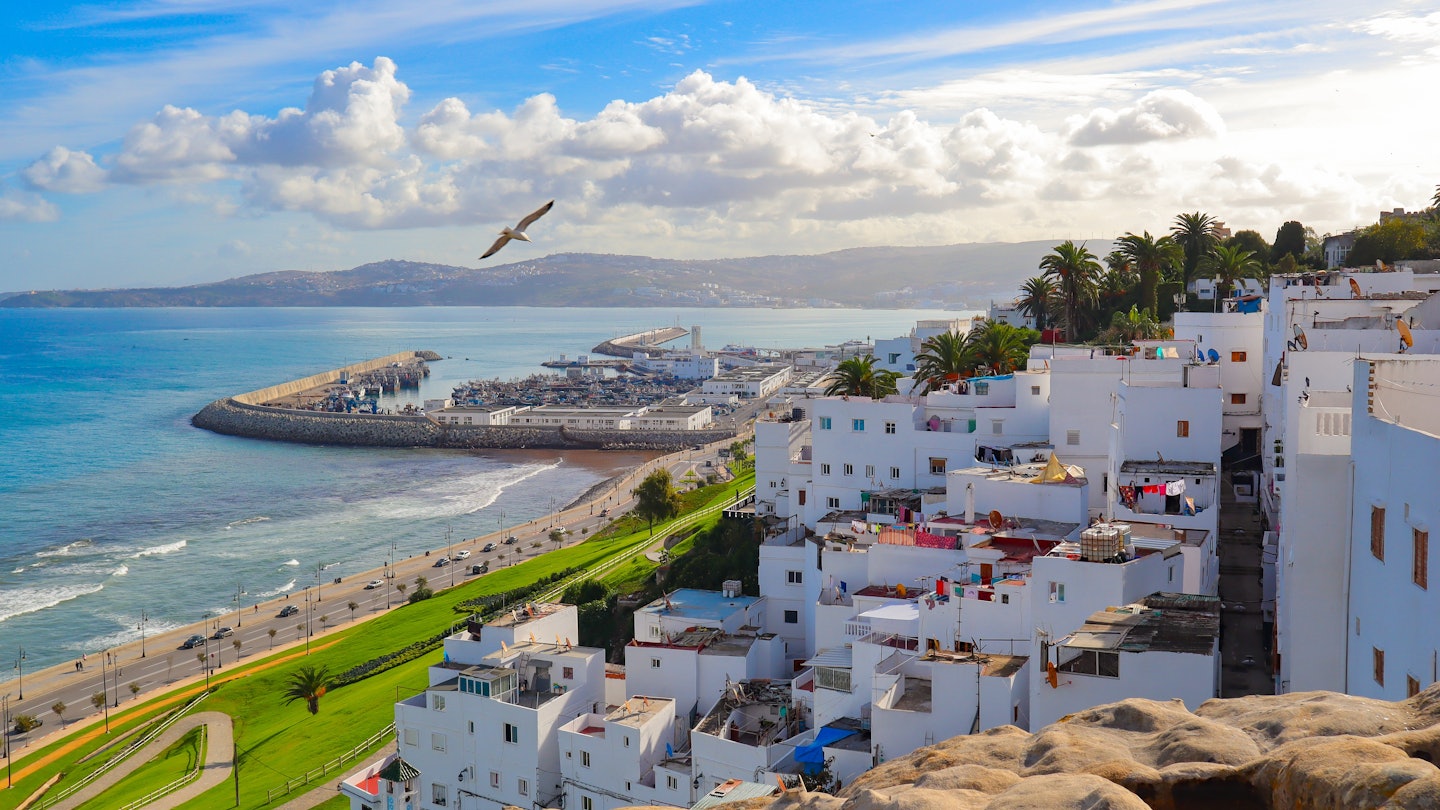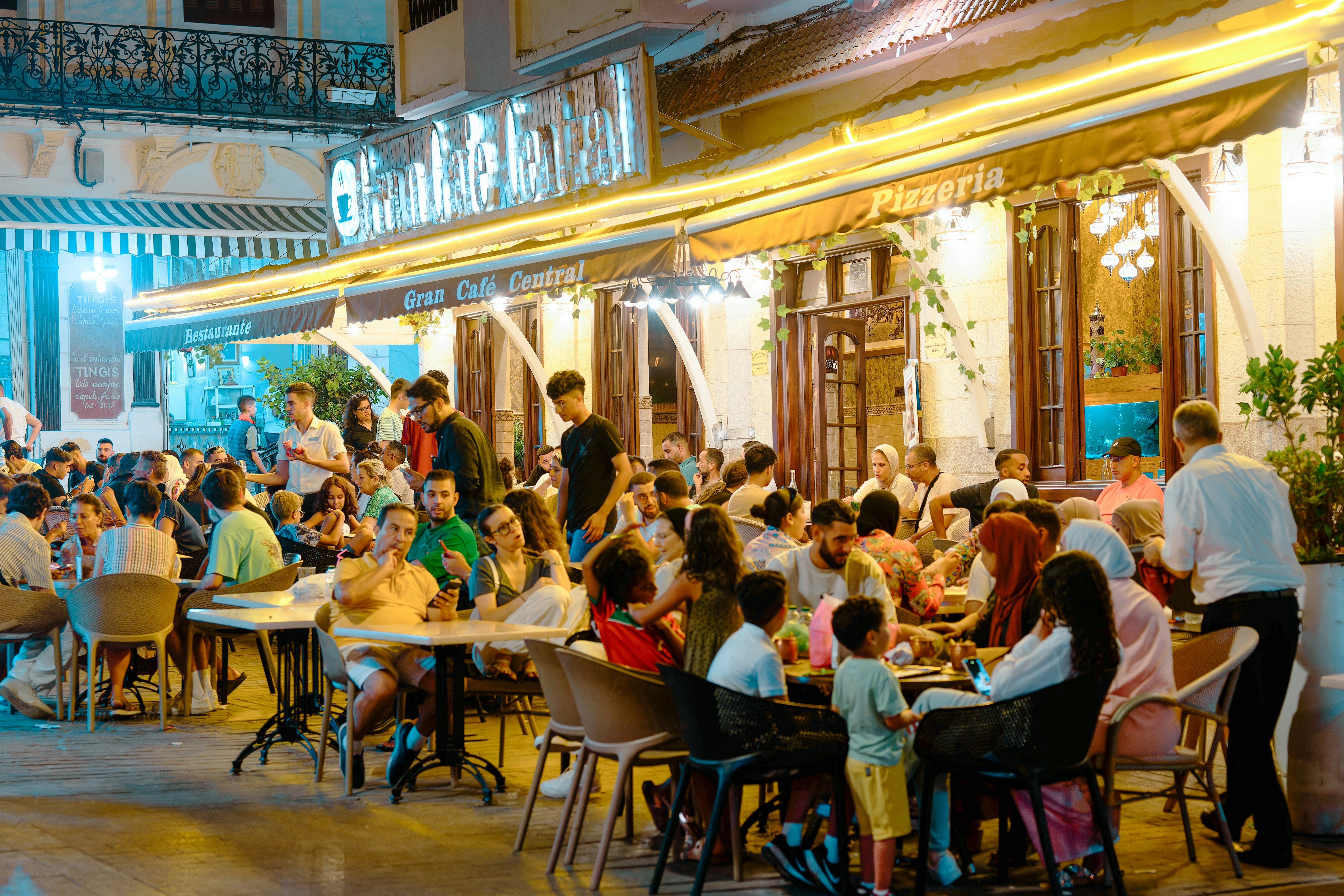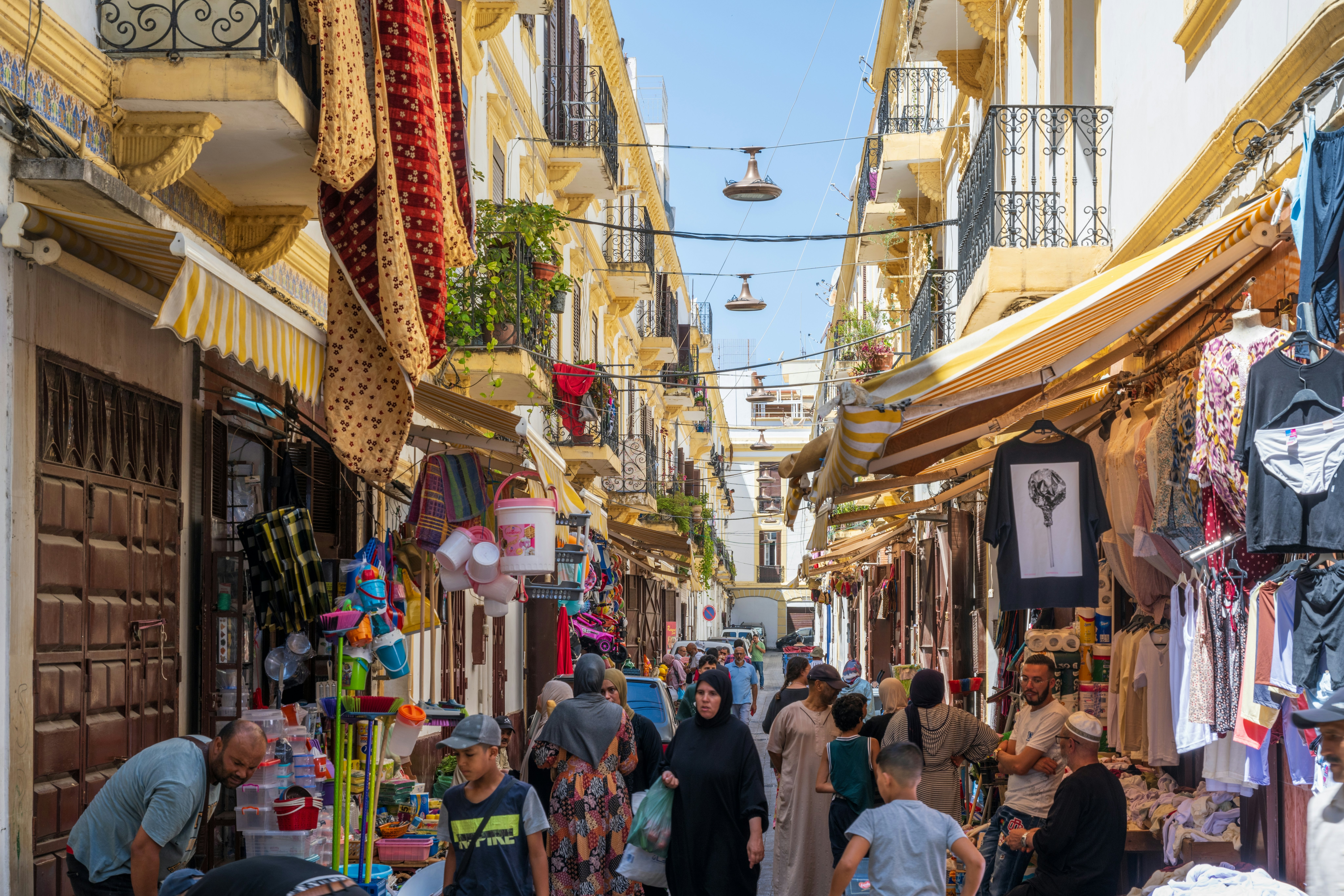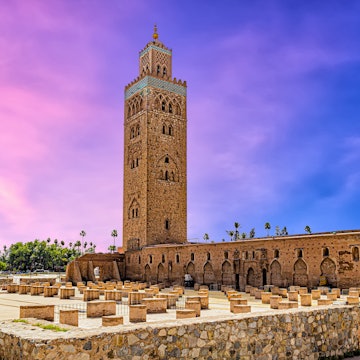

The old medina of Tangier. Morocco lens/Shutterstock
Tangier is one of Morocco’s oldest cities, a meeting place of the Mediterranean and the Atlantic, Europe and Africa. Over the centuries, numerous cultures have left their mark, including the Romans, Portuguese and the British. And in 1923, it became an International Zone, attracting writers, musicians, artists and intellectuals with its anything-goes atmosphere.
More recently, massive investment has swept away years of neglect. There’s a new marina, ferry and fishing port, and Africa's first high-speed train runs along the Atlantic Coast to Casablanca, along with fascinating museums, sophisticated restaurants and stylish hotels.
Tangier’s colorful history may be ever-present, but it’s a city looking to the future. Here’s our pick of the best things to do.

1. Meander through the medina
Start in the Kasbah, the highest part of the medina, an amalgam of shady alleyways and sunlit squares, brilliant blue skies and stellar sea views from the Bab Al Bahr. Stop off at the Kasbah Museum of Mediterranean Cultures, where highlights include a Roman mosaic of Venus from Volubilis and giant replica maps.
Meander down to the Petit Socco, the hub of medina action, for a mint tea break in a historic cafe. Nearby, the must-visit Tangier American Legation Museum is the only US National Historic Landmark on foreign soil – don’t miss the Moroccan Mona Lisa, James McBey’s portrait of Zohra. Then check out the fresh produce in the market on the fringes of the Grand Socco, the buzzy square that joins the old city to the new.
Planning tip: End the day with a well-crafted cocktail – the roof terrace of the Hotel Nord Pinus is the
perfect spot for sundowners overlooking the ocean – before dining alfresco on fine Morocco-meets-Mediterranean fare at Villa Mabrouka’s L’Orangerie.
2. Take a (mint) tea break at an iconic cafe
Tangier has a legendary cafe culture, and you could spend hours watching the world go by over a nous nous (half espresso, half milk). For prime people watching in the medina, go alfresco at the Gran Café Central on the Petit Socco or at the neighboring and equally historic Café Tingis. And tucked down a skinny alleyway, the hole-in-the-wall Café Baba is still as smoky as when it was a favorite hangout of the Beat poets and the Rolling Stones.
On the Place de France in the Ville Nouvelle, the Gran Cafe de Paris is from the epoch of spies and secret agents (and The Bourne Ultimatum).
Detour: A 15-minute walk west of the medina, Café Hafa has been a much-loved cafe since 1921, with some of the best sea views in the city, especially at sunset.

3. Shop-til-you-drop for Moroccan design
Las Chicas is the city’s original concept store, showcasing contemporary Moroccan designers alongside their own creations. Kasbah Collective and Au Fil de Tanger stock locally designed clothes, jewelry and homeware. Laure Welfling’s namesake boutique has the air of a quirky antique store, filled with colorful, richly embroidered clothes. In the Ville Nouvelle, Habibi Burton and New Tangier create high-end designs using traditional crafts.
Detour: If T-shirts are more your thing, check out the cool collection at Rock da Kasbah; it’s also home to the diminutive Donkey Museum.

4. Cook up a storm at Blue Door Cuisine
For a hands-on Moroccan culinary experience, head to one of Blue Door Cuisine’s bright and airy venues where, over the course of three hours, you can learn to rustle up a tasty tagine or couscous, traditional bread, and discover the art of tea-making. Then sit down to enjoy the fruits of your labor, and chat with your multilingual Moroccan experience leader.
Trips to the souq, aromatic stores filled with pyramids of mysterious spices, a community oven or ferran – an almost subterranean stone-walled space where trays of khobz (bread) dough are baked in a wood-fired oven – or the raucous fish market can also be arranged with notice.
Planning tip: Book at least 48 hours in advance. If you’re short of time, the Moroccan Cooking Express experience takes 90 minutes.
5. Take a leisurely stroll along the Corniche
The regeneration of Tangier’s seafront includes the new fishing port, ferry port and the broad Corniche that stretches for 5km (3 miles) around the curve of the bay. Backed by Blvd Mohammed V with its rich mix of architectural styles, there are plenty of green spaces to sit and soak up the sea views.
At its western end, the contemporary Tanja Marina Bay juts into the sea, with space for boats and superyachts and trendy lounge bar-restaurants, such as Chiringuito. On a clear day, you can make out the whitewashed buildings of Tarifa in Spain.
Detour: For a fishy feast, head to the longstanding favorite Saveur de Poisson to enjoy a fixed menu of fish soup, catch-of-the-day and just-baked bread (cash only).

6. Explore Tangier’s literary legacy
The city has a rich literary tradition, from the Beat poets to modern Moroccan writers, and bibliophiles will love exploring its bookstores. Opened in 1949, Tangier institution Librairie des Colonnes has a wide selection of books in numerous languages, plus readings and events.
Among the attention-grabbing stores and galleries along Khalid Ibn El Oualid, Les Insolites is a beautifully curated bookshop and gallery hosting interesting events, and Kiosk is the home of nonprofit cultural collective Think Tanger, dedicated to promoting art and creativity, with books, magazines, art prints and more.
Detour: The Tangier American Legation Museum has a wing dedicated to American author Paul Bowles, who settled in Tangier in 1947 and remained until he died in 1999.
7. Go gallery hopping
The city’s contemporary art scene is booming, with independent galleries springing up around the city. Set the scene at the Villa Harris Museum, where the collection includes the Moroccan artists who helped shape the country’s contemporary art scene, including Farid Belkahia and Mohamed Hamri.
Galerie Delacroix is part of the Institut Français and hosts free temporary exhibitions that are always worth a look. Gallery Kent showcases a new generation of Moroccan artists, and with three locations in the medina, the influential Galerie Conil specializes in contemporary and art brut.
Detour: The Foundation pour la Photographie is set in a beautiful villa, around 3.5km (2 miles) from the medina, with interesting temporary exhibitions and a small shop.

8. Watch the Mediterranean meet the Atlantic at Cap Spartel
The headland of Cap Spartel is the most northwesterly point of mainland Africa, with panoramic views over the meeting point of the cobalt Atlantic and turquoise Mediterranean. Its iconic Hispano-Moorish lighthouse is the oldest in Morocco and home to a small museum.
Just a 15-minute drive south is the Grottes d’Hercule, where the mythical Greek hero is said to have rested after separating Europe and Africa. Here, two caves await: one features waterfalls and somewhat kitschy decor, while the other is famed for its African continent-shaped opening through which you can view the ocean. Sidi Kacem is a sweeping sandy beach nearby.
Detour: Another 40km (25 miles) further south is the pretty seaside town of Asilah, where an annual arts festival leaves vibrant murals on its whitewashed medina walls.
9. Rock the Kasbah
Tangier has an eclectic music scene. Les Fils du Détroit is a wardrobe-sized venue in the medina that’s popular with Arab-Andalusian musicians; pop in for a mint tea and listen to them strum lute-like ouds and beat darboukas (goblet drums). The historic Dar Gnawa is the medina home of master musician Abdellah El Gourd, showcasing the Gnawa tradition and its connections with jazz. Or head to Bayt Tarab, a cafe with traditional Moroccan music and mint tea every evening.
Planning tip: Tangier celebrates local and international jazz musicians at the annual Tanjazz festival in September. And with brass bands parading through the medina and electronic after-parties, you don’t have to be a jazz buff to enjoy it.

10. Ride Africa’s fastest train to Rabat
Board the Al Boraq at Tangier Ville and one of the world’s fastest trains will whiz you to the Moroccan capital, Rabat, in 80 minutes at speeds of around 300km/h (186mph). Named after a mythical winged horse, this sleek French TGV lookalike covers 323km as it hugs the Atlantic coast, the first phase of an ambitious high-speed rail network that will crisscross the country. And you’ll be going green; the train gets 50% of its power from renewable energy and aims to be 100% sustainable in the future.
Detour: On Al Boraq, you can reach Casablanca, Morocco’s largest metropolis, in just under two hours.
11. Celebrate a cinematic city
Cinephiles might recognize the sets from films such as The Sheltering Sky and Spectre. Now some of the city’s iconic cinemas, including Cinema Roxy and Cine Alcázar, have been restored and reopened. The trend began with the Cinema Rif, a 1930s landmark on the Grand Socco, which was rescued from demolition and reinvented as the Cinémathèque de Tanger. Today it offers an eclectic program of films, and its retro cafe is a creative hub for digital nomads, with tables that spill onto the square, perfect for people-watching.
Planning tip: Every autumn, the city hosts the Tangier Film Festival, showcasing thought-provoking films, documentaries and animation.
















